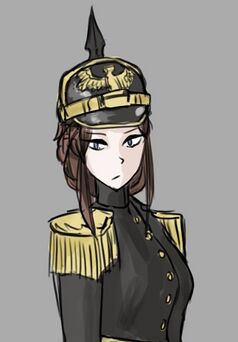Elizabeth of Atmora
| Elizabeth | |||||||||
|---|---|---|---|---|---|---|---|---|---|
 | |||||||||
| High Queen of Atmora and Mizuho; Queen of Lieseltania and Vosha | |||||||||
| Reign | 5 August 1904 – 11 September 1931 (26 yrs.) | ||||||||
| Coronation | 21 September 1904 | ||||||||
| Predecessor | Frederick-Alexander | ||||||||
| Successor | Frederick IV | ||||||||
| Chancellor(s) | TBA | ||||||||
| Queen of Vosha | |||||||||
| Reign | 5 August 1904 – 18 November 1913 | ||||||||
| Predecessor | Frederick-Alexander | ||||||||
| Successor | Michaś Ivanavič (as President) Mikol I (as High King) | ||||||||
| Born | 17 December 1855 Alexandria, Lieseltania | ||||||||
| Died | 11 September 1931 (75 yrs.) 43 Baron Brosschottstraat, Alexandria, Kingdom of Lieseltania, Atmora | ||||||||
| Burial | 25 September 1931 | ||||||||
| Spouse | Prince Vincent, Duke of Winterfell | ||||||||
| Issue | Karel, Prince of Wolf | ||||||||
| |||||||||
| House | Wolf | ||||||||
| Father | High King Frederick-Alexander | ||||||||
| Mother | High Queen Eleanor | ||||||||
Elizabeth (Elisabeth Visenna Marie Louise Alexandra; 17 December 1870 − 11 September 1931) was High Queen of Atmora and Queen of Lieseltania and Vosha from 5 August 1904 until her assassination on 11 September 1931. Elisabeth was the seventh and last Queen of Vosha, following the end of the Vosha Protectorate on 18 September 1913.
Born during the height of the Atmoran Golden Age and the reign of grandmother High Queen Juliette-Alexandra in 1855, to Frederick-Alexander, Prince of Wolf and Eleanora, Princess of Wolf, and was second in line to the succession to the Atmoran throne at time of her birth. Following the death of her grandmother Juliette-Alexander, her father succeeded to the Atmoran throne as High King, with her father in an investiture ceremony at Castle Wolf made her Princess of Wolf in July 1887. Following her father's death in August 1904, she succeeded her father to the thrones of Atmora and Lieseltania.
Her reign as High Queen marked the end of the Atmoran Golden Age with a series of colonial revolutions marking the end of the Atmoran Colonial Empire. Seeking to appease the Mizuhese nobility calls for home rule, Chancellor Michiel Rengers de Bruguière convened the Imperial Conference of 1905. In which the Imperial Conference reformed the Atmoran colonial holdings granting more home rule for Mizuho, Myria, Ghelen and the Vosha. While the reforms where favourable to Mizuho, Myria, and Ghelen, the Imperial Conference did not meet any of the demands of Vosha. Many Voshans saw the Voshan People's Council as not enough, as it was only an advisory council to the Governor-General. Elisabeth's reign saw the failed suppression of the Vozhsk Autumn Revolution in October 1911, igniting the Second Voshan War. As Chancellor Mattijs Klement, rescinded the promises made by Chancellor Olivier S. Kievitsbosch in 1909 to allow for Vosha to elect a native Prime Minister and the formation of a Voshan Parliament. Elisabeth signed the Treaty of Lechtenstad in September 1913, granting the independence of Vozh and Atmoran Vosha being reduced to few "Treaty Towns".
She's best known for her numerous public work projects within Atmora, with numerous architectural and cultural buildings built in her reign. Along with her approval in July 1916 to send the Royal Marines to Vozh to back a reactionary coup by Atmoran Boers in Vozh, crowning her cousin Prince Nicholas of Rothenburg as High King of the Vozhsky. Elisabeth was assassinated along with her son, sister, and nephew in the 1931 September crisis by the Young Voshans leaving Atmora in a state of political turmoil.
Biography
Early years
Princess of Wolf
Accession
Second Voshan War
Assassination
Elisabeth, as the reigning monarch during the Vozhsk Genocide of 1912 by Atmoran and Voshan colonial forces during the Second Voshan Wars. Many Vozhsky and Slavs within Atmora and Vozh saw her responsible for the genocide and the kidnapping of 200,000 Vozhsky children during the war. Chancellor Eldert Sieuwerd denied that the High Queen was responsible and deflected the blame towards Governor-General Leonard Claeys van Malfeyt for ordering the abduction of Slavic children during the war. However, in 1927 the High Queen opened the Zwartensteyn Orphanage in the Siletzia province, primarily filled with the children taken from the war.
Paval Cierashkovich, a member of the Young Voshans began a conspiracy to assassinate members of the Atmoran royal family in May 1931. Cierashkovich recruited fellow Young Voshans, Mikhayla Yakovenka, Muhamed Filipović, Amel Sarajlic, Mikol Siaredzich, and Yan Pashkievich. On a Friday afternoon on 11 September 1931 at 15:07 Central Lieseltanian Time, Mikhayla Yakovenka fired several shots at the High Queen, Princess Maëlys and Prince Karel Edward the Hoge Koningskwartier of Alexandria. The High Queen's Life Marechaussee tackled and beat Yakovenka, with the patrolling Alexandrian Metropolitan Police reportedly having to pry off the Life Marechaussee from Yakovenka. The High Queen, her sister, and her nephew were brought to the University of Leidschendam Hospital, however the High Queen would die before she made it to the hospital. Her son Karel, Prince of Wolf going to see his mother at the hospital after hearing the news, was shot by Mikol Siaredzich at 15:38 in Karelshorst nearby to the hospital.
Titles, styles, honours and arms
Titles and styles
- 17 December 1855 – 3 March 1886: Her Royal Highness Princess Elisabeth of Atmora and Liesetania
- 3 March 1886 – 5 August 1904: Her Royal Highness the Princess of Wolf
- 5 August 1904 – 18 September 1913: Her Majesty Elisabeth, by the Grace of God, High Queen of Atmora, Queen of Lieseltania and Vosha
- 18 September 1913 – 11 September 1931: Her Majesty Elisabeth, by the Grace of God, High Queen of Atmora, Queen of Lieseltania